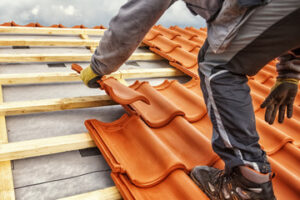A clean roof protects your home from the elements. It also increases your home value and boosts curb appeal. It is a good idea to clean your roof at least twice per year.

The most common method for cleaning a roof is with a bleach solution. Bleach can kill algae, lichen and fire moss on the roof. It can also make dark patches of moss disappear. Contact Roof Cleaning Sarasota for professional help.
When debris removal is being done outside a structure, such as an apartment complex or a home, it is important to make sure the area is clear before beginning. This step will help ensure the safety of individuals who live in or visit the area, as well as protect surrounding plants that can be contaminated by bleach or chlorine solutions used for roof cleaning. Often, this involves removing any standing water from the area and clearing away any debris that could fall into the cleaning solution or clog the gutters during the process.
Dirty roofs are not only a eyesore, but they can actually damage the roofing materials. The growth of algae, moss, and mildew eat away at the surface of the shingles, eventually causing them to crack and tear over time. Regular roof cleaning can prevent these types of problems and lengthen the life of the roofing material.
A dirty roof can also absorb more heat and lead to higher energy bills, especially during the hot summer months. Cleaning the shingles and removing debris can help lower energy costs.
Debris removal when it comes to roofing can be a difficult task that requires special equipment and skill. If the debris is large or located in a hard-to-reach area, it may be necessary to hire a contractor with specialized equipment.
Depending on the type of debris, it may also be necessary to dispose of it safely. This can be done by recycling items that can be repurposed or by properly disposing of hazardous materials. It is important to use proper disposal methods so that the debris does not end up in lakes or rivers, where it can harm wildlife.
In some cases, debris removal may be covered by insurance. However, this typically only applies if the debris was caused by a natural disaster or other covered peril. In these cases, the insurer will reimburse homeowners for the cost of cleaning and restoring their property. This is a great benefit for homeowners, as it can help them avoid expensive repairs and rebuilding expenses.
Power Washing
Power washing is the process of spraying pressurized water onto surfaces outside of your home. This technique cleans contaminants, including dirt, mildew, algae, and moss build-up that can cause damage over time if left untreated. Power washing is an effective way to extend the lifespan of exterior materials, including your roof.
The cost of power washing varies according to the size and condition of your roof, as well as the type of cleaner you use. A heavy infestation of moss or algae will require more intensive cleaning, which drives up the price. In addition, some cleaning methods are more expensive than others, depending on the equipment and chemicals used.
Regardless of what method you choose to clean your roof, it’s important to put safety first. Before you start, make sure to grab all the necessary tools and supplies. A soft-bristled brush, a garden hose with a spray nozzle, and a non-corrosive cleaner are the essentials. Then, move any patio furniture away from the area so that it’s safe to access. Once you’re ready to start, begin by sweeping away any loose debris, leaves, twigs, or dirt that’s scattered on the surface. This will provide more traction when you’re walking across the surface, and it will prevent soiling from stray splashes of cleaner.
Next, if you’re using a pressure washer, make sure to limit the water flow and temperature to avoid damaging your roof’s materials. For instance, a high-pressure washer may be suitable for metal or some types of resilient roof tiles but can cause harm to asphalt shingles. Then, apply the cleaner of your choice, following the manufacturer’s instructions. Some cleaners are intended for certain roofing materials or specific stains, so be sure to use the correct one for your needs.
While it’s possible to clean your own roof, we highly recommend hiring a professional to do so. Not only will this protect your health and safety, but it will also ensure that the job is done properly. If you insist on doing it yourself, be sure to wear protective gear like gloves, goggles, and slip-resistant shoes. In addition, it’s best not to climb your roof shortly after rain. Wet moss and algae are incredibly slippery, and falling off of the roof can be extremely dangerous.
Soft Washing
Soft washing is a cleaning method that combines low-pressure power washing with soaps, solutions, and disinfectants to clean surfaces. This cleaning process can be used on a variety of surfaces around your home, including roofs and siding. This is a safer option than using high-pressure washers because it reduces the risk of damage to delicate areas. It is also a more environmentally friendly way to clean your house.
Using this type of wash can help eliminate moss, mold, mildew, and other organic growth from your roof and exterior surfaces. It can also kill the roots of these organisms, making it difficult for them to grow back. If you are planning to use this method, be sure to prepare the area by covering any greenery that might be impacted. In addition, you will need to wear rubber gloves and masks to protect yourself from the chemicals.
While power washing can destroy tough stains and dirt build-ups, soft washing will slowly but surely eat away at them from the inside. It uses a higher concentration of chemicals to remove these organisms, and you will need to let the chemicals sit for longer than they would with a normal pressure washer. In addition, the surfactant that is included in a soft wash will improve the water’s ability to wash away unwanted gunk.
The soft wash technique is best for cleaning shingles and other fragile structures around your home. It is a safe alternative to pressure washing, and it will not damage your roof. This method can also reach hard-to-reach areas that may be impossible or dangerous to get to with a pressure washer. This includes areas that are painted; areas adjoining rooted plants; brick, paver, and tile; cement block walls; coquina; vinyl; wood panel siding; and cedar shake shingles.
When hiring a professional for your soft washing project, keep in mind that they will need to be trained and certified to ensure that they can safely clean your property without causing damage. They will also be familiar with the different types of cleaners and their applications. It is also important to know that different cleaning methods require different levels of water-to-chemical ratios, so you should always consult a professional before choosing which one will be right for your needs.
Hiring a Professional
When hiring a roof cleaning service it is important to research the company, read reviews and communicate with past customers. The best companies will provide quality work at a fair price. They will also stand behind their work and offer warranties. They will take the time to clean every nook and cranny of your home. They will also conduct a thorough survey after the job is complete to ensure that they have cleaned everything that needs to be cleaned and that there are no areas that may need additional attention.
A professional roof cleaner is a licensed, insured and experienced cleaning company that knows how to treat different types of roofing materials and surfaces. They understand how to use the right level of water pressure and chemical products to ensure that your roof is cleaned without damaging it. They will not only clean the surface of your roof but they will also clean your gutters and check for any signs of damage that need to be addressed.
If you hire an unlicensed or inexperienced roof cleaning contractor you could end up with expensive repair bills. They may not know how to handle the power washer correctly and you could wind up with tiles that have been broken or shingles that are damaged. They may also not know how to properly inspect the condition of your roof and fail to alert you to potential problem areas that need to be addressed.
A professionally cleaned roof not only looks better, but it also helps prevent damage from algae or moss growth and increases the value of your property. It can make your house look newer and more attractive to potential home buyers and shows that you care about your home and are taking the steps necessary to keep it in good shape.
